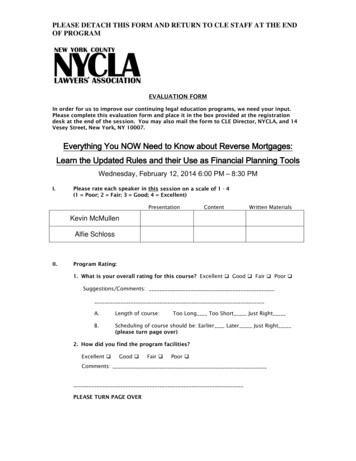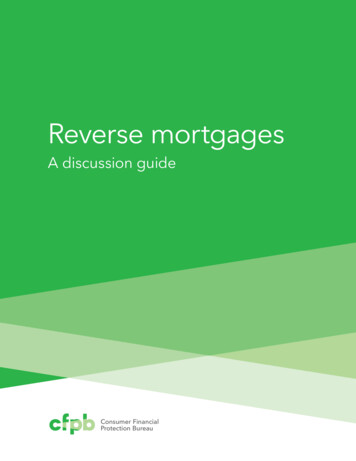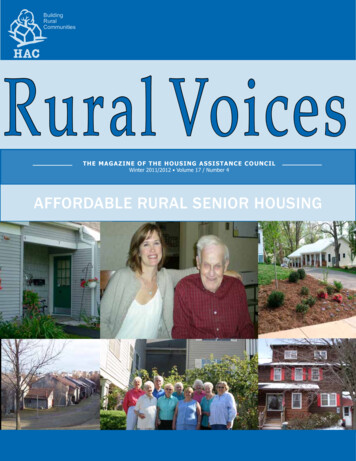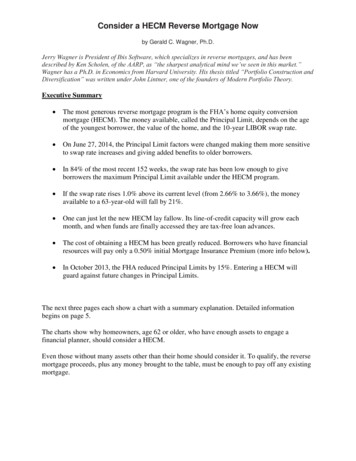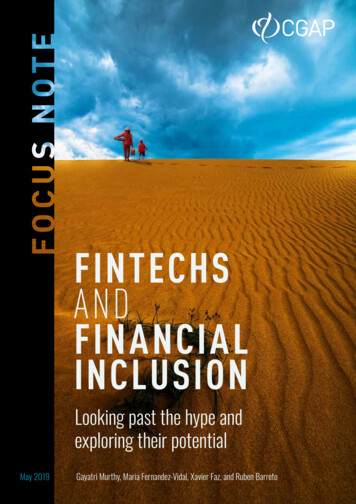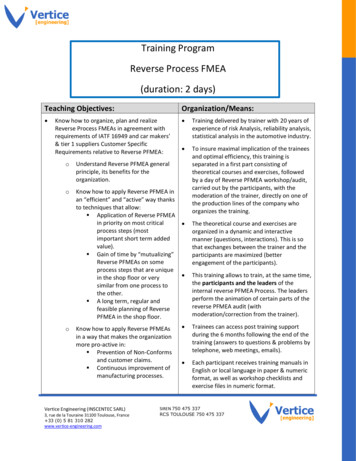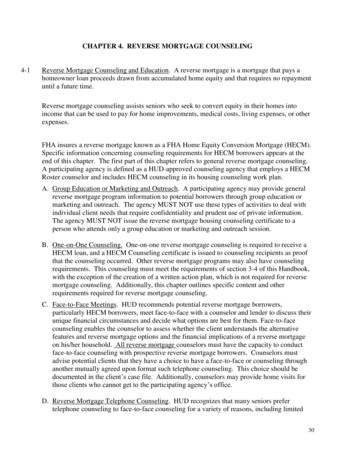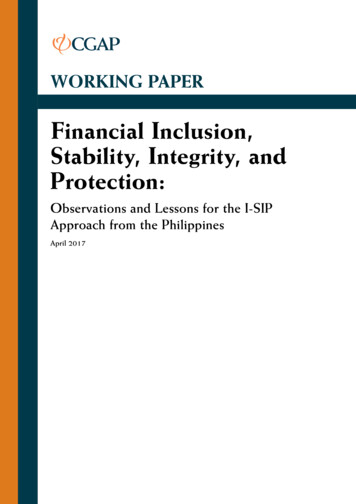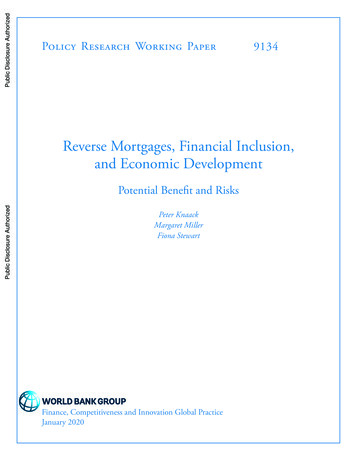
Transcription
Public Disclosure AuthorizedPublic Disclosure Authorized9134Reverse Mortgages, Financial Inclusion,and Economic DevelopmentPotential Benefit and RisksPeter KnaackMargaret MillerFiona StewartPublic Disclosure AuthorizedPublic Disclosure AuthorizedPolicy Research Working PaperFinance, Competitiveness and Innovation Global PracticeJanuary 2020
Policy Research Working Paper 9134AbstractThis paper examines the state of reverse mortgage marketsin selected countries around the world and considers thepotential benefits and risks of these products from a financialinclusion and economic benefit standpoint. Despite potentially increasing demand from aging societies—combinedwith limited pension income—a series of market failuresconstrain supply and demand. The paper discusses a seriesof market failures on the supply side, such as adverse selection, moral hazard, and the costly regulation establishedto address these problems, leading to only a small numberof providers, even in developed markets. Demand-sideconstraints are equally relevant, in particular high non-interest costs, abuse concerns, and the inability of reversemortgages to cover key risks facing the elderly, particularlyhealth and elder care. In developing countries, constraintsare likely to be even higher than in advanced economies, dueto high transaction costs and lack of consumer knowledgeand protection. The enabling conditions for such marketsto develop are outlined, along with examples of regulatoryoversight. The paper concludes that these still seem to belargely products of last resort rather than well-consideredpurchases as part of good retirement planning.This paper is a product of the Finance, Competitiveness and Innovation Global Practice. It is part of a larger effort by theWorld Bank to provide open access to its research and make a contribution to development policy discussions around theworld. Policy Research Working Papers are also posted on the Web at http://www.worldbank.org/prwp. The authors maybe contacted at fstewart1@worldbank.org, mmiller5@worldbank.org.The Policy Research Working Paper Series disseminates the findings of work in progress to encourage the exchange of ideas about developmentissues. An objective of the series is to get the findings out quickly, even if the presentations are less than fully polished. The papers carry thenames of the authors and should be cited accordingly. The findings, interpretations, and conclusions expressed in this paper are entirely thoseof the authors. They do not necessarily represent the views of the International Bank for Reconstruction and Development/World Bank andits affiliated organizations, or those of the Executive Directors of the World Bank or the governments they represent.Produced by the Research Support Team
Reverse Mortgages, Financial Inclusion, and Economic Development:Potential Benefit and RisksPeter KnaackMargaret MillerFiona Stewart(World Bank)JEL Codes: G110, G230, G280, F380Key words: reverse mortgage, pension, consumer protection, housing finance, aging
1. Introduction - summaryPension systems around the world are facing serious, multidimensional challenges. Policy makers aregrappling with the demographic phenomenon of aging societies, a low-interest financial environmentthat provides insufficient returns on pension savings, and policy legacy issues such as low contributionrates, generous retirement age and early withdrawal rules. All these issues affect the replacement rateof pensions and raise the risk of old-age poverty.Policy makers in many developing countries must take additional factors into account. Higher rates ofinformality and greater fluctuation in the labor market lead to relatively low contribution density, and aconsiderable portion of society is not covered by public pension systems at all. In addition, the risk ofold-age poverty is rising as urbanization and demographic changes lead to an erosion of traditionalfamily support systems.The academic literature on the topic suggests that reverse mortgages (RM) can be a welfare-enhancingtool to supplement pension income, or as a form of insurance. In particular, low-income seniorhomeowners may tap into their accumulated housing wealth to smooth consumption and increase theirresilience against financial shocks. The welfare-enhancing potential of this instrument has been modeledin academic studies using data from a variety of jurisdictions. While estimates of potential benefits varywidely by location and model calibration, RM are estimated to be especially beneficial for the veryelderly, women (due to higher longevity and lower pensions on average), and “house-rich, cash poor”households. They might also serve to prevent financial exclusion of retirees who can no longer meet theincome requirements of a common mortgage.However, this brief lays out market failures and risk factors that act as constraints on the supply side ofthe RM market. The risk that housing equity falls below the outstanding loan balance, adverse selection,moral hazard, the high cost of insurance based on imperfect actuarial models, the absence of riskpooling mechanisms that reduce the economic viability of RM for lenders, regulatory disincentives insome countries and market barriers. The combination of these factors may help explain why somebanks, both in rich and developing countries, have exited the RM market in recent years, and why only asmall subset of financial intermediaries chose to enter it in the first place.2
The literature consulted identifies additional factors that constrain demand. RM are relatively complexfinancial products that are difficult to understand, especially for the elderly. The reputation of RM istainted by well-publicized cases of mis-selling and fraud. Maybe most importantly, RM do not addresskey concerns for the elderly, such as precocious dis-saving, longevity risk, and financial stability aftermoving to a nursing home. It may even jeopardize the existing financial safety net for seniors byaffecting their eligibility for social insurance. Cultural factors, including bequest motives, and high noninterest fees further reduce demand. The low penetration rate of the RM market even in advancedeconomies lends credibility to the relevance of these demand constraints.In developing countries, these costs and risks are likely to be even higher than in advanced economies.RM could potentially offer a solution in countries where homeownership is relatively high, but pensioncoverage rates and /or benefit levels are relatively low – for example in the Eastern European region, orin some countries in the Latin America and Southeast Asia regions. However, RM pose particularchallenges for developing markets. Transaction costs can be expected to be higher due to legal certaintyissues (e.g. around land titles) in the housing market and reduced data availability, further reducing bothsupply and demand. Moreover, the potential for fraud and mis-selling is considerable in jurisdictionswhere elderly financial consumers have less effective access to protection and redress for grievances.Thus, the risks and costs associated with RM may equal or even outweigh their benefits in manydeveloping countries.This paper examines the state of reverse mortgage (RM) markets in selected countries around the worldand considers both the potential benefits and risks of these products from both a financial inclusion andeconomic benefit standpoint. The following section provides an overview of RM products. Section 3looks at their potential development benefits. Section 4 outlines international experience. Section 5considers risks and the regulation of these products and Section 6 concludes.2. What are reverse mortgages and how do they function?Reverse mortgages allow elderly homeowners to consume their housing wealth without having to sell ormove out of their homes. The target group for RM are “house rich, cash poor” elderly people who wantto turn their relatively illiquid housing equity into cash. Because the borrower can remain in themortgaged house until they move out or die, this financial instrument provides homeowners with anattractive alternative to selling the house and moving to a smaller or rental property.3
RM origination follows guidelines that are different from that of common mortgages. Unlike typicalmortgages that are repaid in recurring installments, the outstanding loan balance on an RM is repaidonce, at termination. This means that the usual assessments of willingness and ability to pay are notnecessary. The value of the house borrowers pledge as collateral is the only asset of relevance in themortgage assessment. RM are nonrecourse loans, that means borrowers are not liable to repayment ofmore than the house they own, and neither are their spouses nor descendants.Loan size is determined a combination of house price, borrower age, loan costs, and estimated assetprice movements. Because maximum return on the mortgage is capped at the value of the house,lenders must consider different factors in determining loan size. Lenders must estimate the current andfuture value of home equity, and interest rate fluctuations. Since interest on the outstanding loanbalance accrues every year and the loan comes due only when the owner leaves the house (dead oralive), lenders use actuarial models to estimate loan duration based on life expectancy. The lower theinterest rate and the older the borrowers are, the higher the Initial Principal Limit, that is the share ofhousing wealth they can access. Other loan costs such as origination fees, insurance premiums, appraisalfees, and the payments necessary to close pre-existing mortgages are usually incorporated in the RMrather than paid separately. The resulting Net Principal Limit is equivalent to 60%-70% of the houseprice for the average borrower, but subject to regulatory caps in some jurisdictions (see Figure 1).Figure 1: Distribution of Initial Principal Limit in the United StatesSource: Shan (2011)RM are designed specifically for elderly homeowners. Regulatory measures differ across jurisdictions,but it is usually only citizens in retirement age that are eligible for RM. In the United States, the4
minimum age is 62, and the average RM borrower is 73 years old. Over the last two decades, theaverage borrower age is declining as demand among younger retirees is rising (see Figure 2).Figure 2: Age Distribution of Reverse Mortgage BorrowersRM come due at one of several possible “maturity events”. As mentioned above, homeowners can livein the house they mortgaged until the end of their lives without the threat of foreclosure (see Section 4below on US exceptions to this rule). The mortgage must be repaid when the borrower leaves the housefor more than a specified period. If this so-called “maturity event” happens during the borrower’slifetime, the owner can either sell the house to repay the RM (and keep the remaining proceeds) orhand the house over to the lender. If the owner passes away, the heirs have three options: (1) settle themortgage with their own funds and keep the house, (2) sell the house and use the proceeds to settle themortgage, or (3) relinquish the house to the bank, i.e. foreclosure. As mentioned above, heirs do notincur financial responsibilities in case the outstanding loan balance exceeds the value of the house. 1RM offer a variety of disbursement options, from lump sum to annuities. Depending on the jurisdiction,RM lenders offer a lump sum payment or a line of credit, which the borrower can draw on wheneverneeded. Tenure payments are the disbursement option equivalent to pension annuities, where the1This is also the case in Australia under the ‘no negative equity guarantee.’5
borrower receives monthly payments for the remaining life time. Borrowers can also choose to receiveterm payments, that is monthly payments that are made for a fixed period of time as determined by theborrower. In the United States, the large majority of RM clients (87%) opt for a lump sum or line ofcredit whereas 13% choose monthly disbursements (Shan, 2011).RM have commonalities and differences with home equity lines of credit (HELOC). Both financialproducts rely on housing equity as collateral. But unlike RM, HELOC are repaid in recurring installments.That requires potential clients to undergo a credit assessment of their willingness and ability to pay.Many retirees fail to meet income requirements and are thus not eligible for a HELOC. In the UnitedStates, HELOC tend to be more popular in the general population, while many elderly people seekingcredit may have no option other than an RM (see Figure 3).Figure 3: Homeowners with Reverse Mortgage Loan vs HELOCSource: Nakajima (2012)3. Potential development benefitsNew policies and financial tools are needed to address the “lifetime savings puzzle”. Policy makers bothin advanced and developing economies seek to facilitate optimal household savings behaviorthroughout the life cycle as state-sponsored pension and intergenerational family support systems areincomplete or waning. In advanced economies, many employer-sponsored retirement plans have shiftedfrom a defined benefit to a defined contribution system, raising the risk of inadequate post-retirement6
income. In many developing countries, urbanization and the rise of the nuclear family tend to erode thetraditional financial support network for the elderly. Providing citizens with the tools and incentives tofind an optimal balance between pre-retirement income and savings, post-retirement income, andaccess to liquidity to withstand financial shocks is thus of increasing importance (Stewart, Jain, &Sandbrook, 2019).Aging societies present challenges for policy makers in high-income countries, but these challenges areof increasing relevance for developing countries, too. The demise of defined benefit schemes in manyadvanced economies has called the sustainability of current public pension systems into question.Insufficient lifetime savings are a policy problem around the world. But the elderly in developingcountries face additional risk of old-age poverty because the unraveling of the traditional family supportsystem is not fully compensated by modern financial safety nets such as public and private pensionschemes, long-term health care insurance, and social security. The UN reports that while 68% of theworld’s older population receives a pension, this figure is only 26% in Central and Southern Asia and 23%in Sub-Saharan Africa (UNDESA, 2016). Similarly, in high-income economies, 46% of adults save moneyfor old age, against only 16% in low- and middle-income economies (WBG, 2017). This compares withrelatively high levels of homeownership in some emerging markets – particularly in the Eastern Europeregion, and in some countries in Latin America and Southeast Asia. For example, homeownership ratesare over 80% in Lithuania and Mexico, yet these countries are at the bottom of the OECD’s estimatedpension replacement rates. 2In this context, reverse mortgages might be useful as an instrument for consumption smoothing overthe life cycle in some countries. In order to achieve a welfare-maximizing smooth consumption curve,households should accumulate savings during their work life span and draw on their wealth uponretirement, according to the Life-Cycle Hypothesis (Feldstein, 1976; Munnell, 1974; Jappelli &Modigliani, 2006). Pension systems allow retirees to annuitize a portion of their savings. But whilehomeowners dedicate a considerable portion of lifetime savings to their house, the elderly have fewmeans of tapping their accumulated housing wealth (Shan, 2011). Citizens with defined contributionpension schemes in particular may even be dissuaded from becoming homeowners in the first placeHomeownership numbers taken from Wikipedia rankings, complied from Eurostat and national housing datahttps://en.wikipedia.org/wiki/List of countries by home ownership rate.Pension replacement rates estimated in ‘Pensions at a Glance’ publication n/1/2/5/2/index.html?itemId /content/publication/b6d3dcfcen& csp a8e95975da55b0299df9e90b37215621&itemIGO oecd&itemContentType book.27
because their old-age income flow is uncertain (Murray, 2019). Reverse mortgages may help addressthis skewed age-saving profile by allowing elderly homeowners access to their housing equity and thussmooth consumption over the life cycle. Based on this assumption, a variety of studies find RM welfareenhancing for elderly American homeowners (Venti & Wise, 1991; Merrill, Finkel, & Kutty, 1994; Mayer& Simons, 1994). As noted, these products could also prove beneficial in developing countries withrelatively high level of housing ownership, but where pension coverage and /or incomes are morelimited.In particular, RM could benefit “house rich and cash poor” elderly households, although its potential forpoverty alleviation is limited. Several studies find that low-income homeowners are most likely tobenefit from this financial instrument (Chatterjee, 2016; Nakajima & Telyukova, 2017; Ong, 2008). AsDavidoff & Welke (2004) put it: “Reverse mortgages let ‘house rich, cash poor’ older homeownerstransfer wealth from the wealthy period after their home is sold to the impoverished period before.” Atthe same time, the literature does not unequivocally endorse RM as a means of poverty alleviation. Inthe United Kingdom, Hancock (1998a, 1998b) finds that RM have little potential to reduce povertysubstantially among elderly homeowners. Reviewing studies from a variety of advanced economies, Ong(2008) concludes that the benefits of RM for low-income households are uncertain.Women in particular may benefit from RM due to longevity, and on average having lower pensionincomes than men. Despite living longer, pension coverage is lower among women than men in allregions (Arza, 2015). Even when coverage includes women, relatively lower lifetime earnings and alower contribution density to pension systems (due to exiting the labor force for caring duties such asraising children) translates into lower entitlements upon retirement (GPFI & OECD, 2019; Ong, 2008).RM may thus be a particularly useful instrument to help homeowning women avoid old-age poverty.Indeed, in the United States, 45% of RM borrowers are single females, whereas 19% are single males,and 36% are couples (Shan, 2011). However, homeownership differentials by gender in emergingmarkets may exclude more women than men from this potential source of income. 3RM may be used to cover longevity risk and complement pension income. The tenure payment option ofRM allows borrowers to receive monthly payments for a specified period or during their lifetime. Thelatter option may be especially beneficial for women who, with a longer life expectancy, face greaterSee: m-equal-property-rights/.38
longevity risk (i.e. the risk that a person outlives their retirement savings). A tenure payment thusoperates similar to a defined benefit pension scheme, allowing the elderly to secure a sufficient incomein retirement (Chatterjee, 2016; Nakajima, 2012) – though the level of income which a RM can generatevs. a DB pension is likely to be considerably lower.Greater resilience against financial shocks may be another priority for elderly households. Rather thanproviding additional income on a regular basis, households may want access to housing equity to coverthe risk of financial distress in the case of illness, disaster, or property damage. Retirees in particularface a series of idiosyncratic risks regarding life span, health, spouse mortality, and medical expensesthat are not fully covered by existing insurance products. Evidence in the United States supports theargument that the insurance motive is a strong driver for RM: 68% of clients opt for the line-of-creditoptions (rather than tenure payment), and 67% of Home Equity Conversion Mortgages (HECM)counseling clients reported in 2010 that they want to use an RM to reduce household debt rather thansupplement their income (Reversemortgages.com, n.d.; Nakajima & Telyukova, 2017; Venti & Wise,2004; Nakajima, 2012).Old-age financial inclusion is a concern for policy makers. The G20 under the Japanese presidency in2019 has elevated it to one of its policy priorities. G20 leaders may hope that financial inclusion reducespressure on public pension schemes, improves lifetime financial planning, and helps avoid old-agepoverty. Indeed, citizens who are financially included in earlier stages of their lifetime may face financialexclusion in old age due to a lack of salary income, low financial literacy, cognitive and physical decline,and low digital capability among other reasons (GPFI & OECD, 2019). Furthermore, policy makers areinterested in innovative ways of approaching pension systems in ways that can address the demand forlong-term investment options and housing shortages in many countries (Sing & Stewart, 2018).RM may be of interest as an instrument of old-age financial inclusion. Homeowners are not commonlyfinancially excluded. Many are likely to have access to a bank account, and many may have financedtheir home purchase with a mortgage. RM may acquire relevance as a tool for financial inclusion only inthe narrow sense of old-age creditworthiness: Because most elderly people do not receive a salary, theyoften cannot meet income requirements for common loans. RM in turn are available to them becauseeligibility depends solely on age and housing equity (Caplin, 2002). Homeowners may prefer an RM overavailable alternatives such as downsizing or becoming renters.9
Elderly people also consider RM as an insurance against health risk. Research reveals that a largemedical expense shock is the predominant reason to take out an RM in the United States (Nakajima &Telyukova, 2017). The risk of out-of-pocket medical expenditure shocks is considerable for the elderlyliving in countries with patchy health insurance systems, such as the United States and many developingcountries. Health risk concerns may trump bequest motives, that is the desire to pass on accumulatedwealth (such as a house) to heirs (Ameriks, Caplin, Laufer, & Van Nieuwerburgh, 2011; De Nardi, 2004).Supporting evidence is provided by a 2012 comparison between RM holders and non-holders among10,000 homeowners in the United States. The study finds no significant difference in the number ofchildren or the financial planning horizon, but it shows that RM holders are more risk averse and lesslikely to have long-term care insurance (Chatterjee, 2016).However, RM is a flawed health care insurance tool because it does not address elderly care risk. Inaccordance with regulations, RM must be repaid after the last borrower leaves the home. Ifdeteriorating health obliges an elderly person to move to an elderly care facility, they face the risk ofloan termination at a time when their health expenditures rise significantly. In this case, the affectedperson either needs to certify on a regular basis that they are still living in their home or face foreclosureafter one year (Nakajima, 2012). In the United States, the risk of ending up in a residential facility forelder care is estimated to be above 50% (Hurd, Michaud, & Rohwedder, 2013). The failure of RM toaddress elderly care risk may be a key reason why demand for it is so low (see below).RM provides insurance against a decline in house price, albeit at a cost. Borrowers are not liable if thehouse price drops below the outstanding loan balance. Because RM are non-recourse loans, borrowershave to repay only the smaller of the loan balance or house price, and heirs are not responsible for anyoutstanding balance. Lenders do not shoulder this risk either because they are insured, often asmandated by regulation. In the United States for example, the Federal Housing Agency insures lendersagainst this so-called crossover risk, but the (substantial) cost of this insurance is paid in full by theborrower, not the lender (see section 4 for details).RM may help optimize intergenerational wealth transfer – but could put the elderly at risk from abuse.This function is not widely discussed in the literature, and there is scant evidence of it in practice. ButChatterjee (2016) suggests that the elderly can use a RM to pass on their housing wealth to theiroffspring. In the United Kingdom, a portion of asset and income-rich households report using RM to passon an inheritance early (European Mortgage Federation, 2009). Such bequests may be welfareenhancing because they would come at an earlier stage of children’s lifespan, when the demand for10
additional capital is higher. It may also serve as an instrument for tax avoidance in jurisdictions withinheritance taxes. However, the products could also pose a risk to the vulnerable elderly, if forced intoproducts they do not fully understand and to pass on an inheritance when they still have their ownfinancial needs to plan and care for.4. International experienceRM have been introduced mainly in advanced economies, and RM markets there tend to be small. RMare a rather bespoke financial product that caters to elderly people only. It is thus not surprising that RMmostly exist in countries with a relatively high median age and an advanced financial market. The UnitedStates features the oldest and largest RM market to date. Smaller RM markets exist in Canada; Australia;Hong Kong SAR, China; Spain and the United Kingdom (Ong, 2008). Some European countries haveintroduced buy-and-lease-back agreements, where the buyer pays the seller an annuity until death toreceive the home in return afterwards. The following paragraphs present the findings of a selection ofstudies related to RM from the United States; United Kingdom; Australia; Taiwan, China; the Republic ofKorea; Singapore; and India.United StatesThe United States is home to the oldest and largest RM market. A savings and loan company in Mainereportedly originated the first RM in 1961. But it was not until the late 1980s that RM receivedregulatory endorsement. In 1988 The US Department of Housing and Urban Development created HomeEquity Conversion Mortgages (HECM), by far the most popular product with a market share of 95% ofthe RM market to date. The loans are originated by banks and insured by the Federal HousingAdministration.Over the last 20 years, the RM market in the United States has grown considerably. In 1990, HECMorigination was capped at 2,500. RM grew steadily over the years to reach 55,000 in 2016. Growth ratespicked up in the 2000s as housing prices continued to rise. While low-income areas were overrepresented in the RM market in the 1990s, residents living in high-income zip codes were equally likelyto close an RM as poorer ones in the 2000s. Recent data suggest that the trend may have reverted againin the 2010s, since RM market penetration is currently much higher in the bottom income quintile thanthe elderly homeowner population at large (Nakajima & Telyukova, 2017). In the wake of the 200811
housing crash, the RM market has continued to expand (see Figure 4), reflecting a rise in the regulatorycap on RM as well as an increase in the number of baby boomers retiring with insufficient savings,higher medical expenditures, and negative income shocks due to the Great Recession (Shan, 2011;Chatterjee, 2016).Figure 4: Percentage of Older Homeowners with a Reverse MortgageSource: Nakajima & Telyukova (2017), American Housing SurveyNevertheless, the RM market has always remained well below estimates of its potential in the academicliterature. This review notes a significant gap between the rather optimistic accounts of the welfareenhancing potential of this financial instrument and the rather lukewarm response of marketparticipants in reality. Estimates of RM market potential in the United States range widely, from 9% to80% of homeowners above age 69. Optimistic studies assume that all households with home equityabove a certain threshold (e.g. 30,000, see Rasmussen et al., 1997) would benefit from an RM, whilethe more conservative estimates focus on homeowners with high housing wealth and low income only(Nakajima, 2012). The real market penetration of RM remains much below even conservative estimates,at around 2% of eligible homeowners in 2011. In 2016, fewer than 49,000 RM were sold (“Financinglongevity,” 2017). Davidoff & Welke (2004) argue that the RM market is mired in a vicious cycle of lowdemand, leading to difficulty in establishing actuarial estimates. The lack of data leads to relatively highborrowing costs, which in turn keep demand low. 4Section 5 of this brief lays out 11 constraints on the supply and demand sides that help explain the lack of vigor inthe RM market.412
Over time, US regulators have tightened the rules for the RM market in the face of financial distress.Since its creation in 1987, the Home Equity Conversion Mortgage program is administered by theFederal Housing Agency (FHA) and overseen by the US Department of Housing and Urban Development(HUD). The RM program has undergone several regulatory changes in its 30-year history. In response tocostumer protection concerns, regulatory authorities created fee disclosure requirements and educationsafeguards in 1998: potential customers are required to attend counseling by a HUD-approved thirdparty before signing a reverse mortgage contract. Since 2015, customers have to undergo an additionalsuitability analysis to assess their willingness and ability to pay for property taxes and insurance (seesection 5 on risks and regulations). In the wake of the Great Recession, following a surge in RMforeclosures where home equity had fallen below the outstanding loan balance, HUD tightenedborrowing caps and increased the mandatory annual insurance premium (Nakajima, 2012;Reversemortgage
The academic literature on the topic suggests that reverse mortgages (RM) can be a welfare-enhancing tool to supplement pension income, or as a form of insurance. In particular, low-income senior homeowners may tap into their accumulated housing wealth to smooth consumptio
